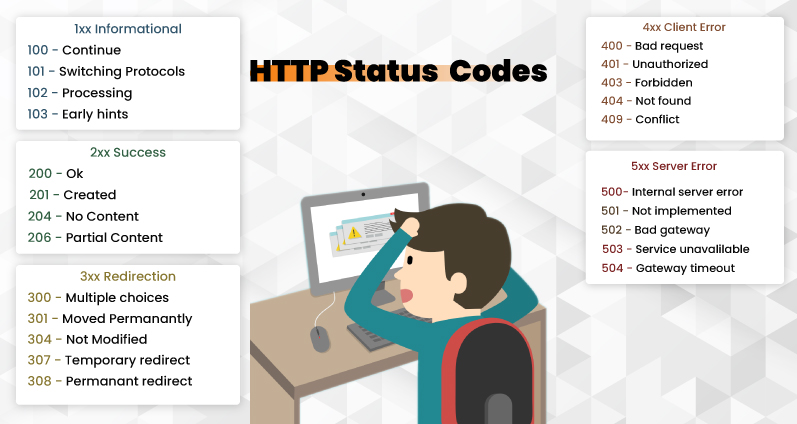server

HTTP status codes
HTTP status codes are three-digit numbers that are returned by a server in response to a client’s request made using the HTTP protocol. Here is a brief overview of some of the most common HTTP status codes:
- 1xx Informational: These are provisional responses indicating that the client’s request has been received and understood, but the server is still processing it.
- 2xx Success: These codes indicate that the server successfully processed the client’s request. For example, 200 OK indicates that the request was successful, and the server is returning the requested data.
- 3xx Redirection: These codes indicate that the client must take additional action to complete the request. For example, 301 Moved Permanently indicates that the requested resource has been permanently moved to a new location, and the client should update its bookmarks or links.
- 4xx Client Error: These codes indicate that there was an error on the client side. For example, 404 Not Found indicates that the requested resource could not be found on the server.
- 5xx Server Error: These codes indicate that there was an error on the server side. For example, 500 Internal Server Error indicates that the server encountered an unexpected condition that prevented it from fulfilling the request.
Here is a complete list of HTTP status codes, grouped by category:
- 1xx Informational
- 100 Continue
- 101 Switching Protocols
- 102 Processing
- 103 Early Hints
- 2xx Success
- 200 OK
- 201 Created
- 202 Accepted
- 203 Non-Authoritative Information
- 204 No Content
- 205 Reset Content
- 206 Partial Content
- 207 Multi-Status
- 208 Already Reported
- 226 IM Used
- 3xx Redirection
- 300 Multiple Choices
- 301 Moved Permanently
- 302 Found
- 303 See Other
- 304 Not Modified
- 305 Use Proxy
- 307 Temporary Redirect
- 308 Permanent Redirect
- 4xx Client Error
- 400 Bad Request
- 401 Unauthorized
- 402 Payment Required
- 403 Forbidden
- 404 Not Found
- 405 Method Not Allowed
- 406 Not Acceptable
- 407 Proxy Authentication Required
- 408 Request Timeout
- 409 Conflict
- 410 Gone
- 411 Length Required
- 412 Precondition Failed
- 413 Payload Too Large
- 414 URI Too Long
- 415 Unsupported Media Type
- 416 Range Not Satisfiable
- 417 Expectation Failed
- 418 I’m a teapot
- 421 Misdirected Request
- 422 Unprocessable Entity
- 423 Locked
- 424 Failed Dependency
- 425 Too Early
- 426 Upgrade Required
- 428 Precondition Required
- 429 Too Many Requests
- 431 Request Header Fields Too Large
- 444 Connection Closed Without Response
- 451 Unavailable For Legal Reasons
- 499 Client Closed Request
- 5xx Server Error
- 500 Internal Server Error
- 501 Not Implemented
- 502 Bad Gateway
- 503 Service Unavailable
- 504 Gateway Timeout
- 505 HTTP Version Not Supported
- 506 Variant Also Negotiates
- 507 Insufficient Storage
- 508 Loop Detected
- 510 Not Extended
- 511 Network Authentication Required
- 599 Network Connect Timeout Error
Each HTTP status code has a specific meaning and is returned by the server in response to the client’s request made using the HTTP protocol. Knowing how to interpret these codes can be helpful in diagnosing and resolving issues when working with web applications or websites.
See More: SEO Optimimization
Ragulaust
0